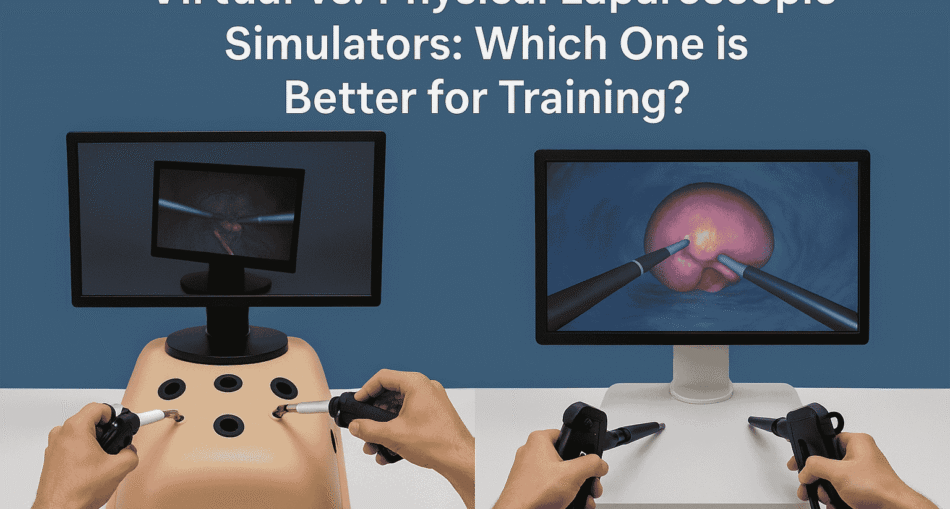In the world of modern surgical education, laparoscopic simulators play a vital role in training aspiring surgeons. With advancements in technology, two prominent types of laparoscopic training systems have emerged: virtual simulators and physical (box) simulators. Both options are designed to improve hand-eye coordination, depth perception, and instrument handling skills. But which one is better for training?
Let’s dive into the key differences, pros and cons, and how to choose the right simulator for your needs.
Understanding the Two Types of Laparoscopic Simulators
-
Physical Laparoscopic Simulators (Box Trainers)
Physical simulators are often referred to as “box trainers.” They are mechanical setups that replicate a real laparoscopic environment using physical tools, ports, and sometimes cameras. Trainees insert laparoscopic instruments into laparoscopic simulator ports and practice tasks like suturing, knot tying, or object manipulation using real instruments and materials.
-
Virtual Laparoscopic Simulators
Virtual simulators, on the other hand, use computer-generated environments. These high-tech systems provide a digital interface where students interact using specialized haptic tools. The software simulates real-life laparoscopic procedures, providing feedback on performance metrics such as precision, time, tissue handling, and more.
Comparing Key Features
| Feature | Physical Simulator | Virtual Simulator |
| Realism in Instrument Handling | High (uses actual tools) | Moderate to High |
| Visual Feedback | Depends on camera quality | Advanced 3D visuals |
| Performance Tracking | Manual observation or external software | Built-in analytics |
| Learning Curve | Steady, with tactile feedback | May feel unnatural at first |
| Cost | More affordable | Significantly more expensive |
| Maintenance | Low | Requires regular software updates |
| Availability | Widely available | May require infrastructure setup |
| Customization | Limited | Highly customizable scenarios |
Advantages of Physical Simulators
Hands-on Feel: They offer the tactile feedback of handling real instruments, which is crucial for developing muscle memory.
Cost-effective: Perfect for institutions or individuals with a limited budget.
Flexible Practice: Trainees can repeat exercises anytime without needing technical support.
Portable: Lightweight and easy to set up in multiple locations.
However, physical simulators may lack standardized feedback unless additional software or expert supervision is available.
Advantages of Virtual Simulators
Detailed Performance Metrics: From motion tracking to tissue damage reports, virtual simulators offer rich feedback to help learners improve.
Risk-Free Environment: Trainees can make mistakes without any real consequences, encouraging exploration and learning.
Scenario Variety: They offer preloaded clinical cases, complications, and varied difficulty levels, simulating real-world surgical challenges.
Haptic Technology: Some advanced systems offer force feedback to mimic the resistance felt during surgery.
The main drawback of virtual systems is their high cost and technical dependency.
Which One is Better?
The answer isn’t black and white — it depends on your training goals, budget, and institutional infrastructure.
Choose Physical Simulators If:
- You’re a beginner needing to master basic motor skills.
- Your institution or personal budget is limited.
- You want frequent, repetitive practice without setup delays.
Choose Virtual Simulators If:
- You’re at an intermediate or advanced level and want comprehensive performance feedback.
- Your institution can invest in high-end simulation labs.
- You require a variety of surgical scenarios for exam or real-life preparation.
Hybrid Training – The Best of Both Worlds
Many institutions are now adopting hybrid training models, combining physical and virtual simulators. Trainees begin with box trainers to develop fundamental hand-eye coordination, then progress to virtual simulators for advanced performance tracking and complex scenarios.
This combination ensures a more comprehensive, step-by-step learning experience, blending tactile skill with analytical insight.
Final Thoughts
Both physical and virtual laparoscopic simulators have their own unique strengths. Physical trainers offer realism and affordability, while virtual simulators provide sophisticated data-driven learning. Instead of choosing one over the other, the ideal solution might lie in integrating both methods into a structured training curriculum.
Whether you’re a student, trainer, or institution, consider your needs, resources, and goals before making a decision. After all, the ultimate aim is to create confident, competent surgeons who are ready for the operating room.







